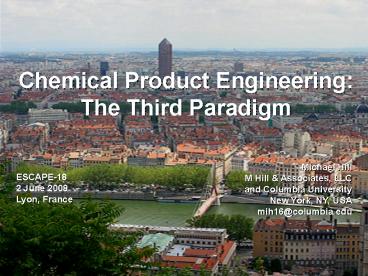Chemical Product Engineering: - PowerPoint PPT Presentation
1 / 25
Title:
Chemical Product Engineering:
Description:
... largely ignored all product issues other than costs and purity as irrelevant ... Homogeneous Products ... Structured Products ... – PowerPoint PPT presentation
Number of Views:96
Avg rating:3.0/5.0
Title: Chemical Product Engineering:
1
Chemical Product Engineering The Third Paradigm
Michael Hill M Hill Associates, LLC and
Columbia University New York, NY,
USA mih16_at_columbia.edu
ESCAPE-18 2 June 2008 Lyon, France
2
What Is a Chemical Product?
- Functional material which meets specific need
- Performance chemicals
- Semi-conductors
- Pharmaceuticals
- Paints
- Personal Care products
- Processed foods
- Household products
- Devices
3
Commodities vs. Products
- Commodities
- Compositional spec
- Generic
- Low margin
- High volume
- Process-centered
- Products
- Performance spec
- Differentiated
- High margin
- Often low volume
- Product-centered
4
Trend Affecting ChE Employment
Cussler Wei, AIChE J, 49 1073
5
What Can ChEs Contribute?
- Designing a product should benefit from
understanding of behavior during use - Product use is a process
- Same fundamental knowledge base for understanding
product manufacture can also provide
understanding of product use
6
Similarities Differences
- Process Design
- Product is specified but process is not
- Focus on models of manufacturing process
- Search technique to select among process
alternatives - Goal is lowest cost manufacturing process
- Product Design
- Neither product nor process is specified
- Focus on models of product properties
- Search technique to select among product
alternatives - Goal is added value through enhanced product
properties
7
Similarities Differences
- Process Design
- Product is specified but process is not
- Focus on models of manufacturing process
- Search technique to select among process
alternatives - Goal is lowest cost manufacturing process
- Product Design
- Neither product nor process is specified
- Focus on models of product properties
- Search technique to select among product
alternatives - Goal is added value through enhanced product
properties
8
Product Design Engineering require new mindset!
9
(No Transcript)
10
What is a paradigm?
- Thomas Kuhn (1962) Specific way of viewing
scientific reality, the mindset of a scientific
community - Affects both choice of problems and acceptable
approaches for solving - Inadequacies frequently minimized or ignored
- If and when paradigm reaches a crisis, a new
paradigm will arise
11
Chemical Engineering Paradigms
- Early chemical engineering
- First Paradigm Unit Operations
- Second Paradigm Chemical Engg Science
12
Why a Third Paradigm?
- Chemical engineering community largely ignored
all product issues other than costs and purity as
irrelevant - Focused on processing while leaving product
development to chemists - Chemical engineering has been synonymous with
process engineering
13
Need a product engineering mindset to solve
problems where both product and its
manufacturing process must be identified!
14
How Should Products Be Developed?
- Historically scientific experimentation
- Often accelerated through either high-throughput
experimentation or experimental design, yet both
inherently limited - Better systematic way to identify problem
solutions that minimizes experimentation
15
Role of Product Design
- To specify a small set of formulations likely to
meet product requirements, confirmed or refined
through experimentation - Phase of chemical product development preceding a
more focused experimental program
16
Product Design Algorithm
- Cussler Moggridge
- Identify customer needs
- Generate ideas to meet those needs
- Select among the ideas
- Manufacture the product
17
Product Design Algorithm
- Cussler Moggridge
- Identify customer needs
- Generate ideas to meet those needs
- Select among the ideas
- Manufacture the product
18
How to Do This?
- Creativity techniques can help, but need more
than just brainstorming and selection - Need a generic methodology to systematically
transform each novel approach into set of product
alternatives, and to quantitatively analyze those
alternatives
19
Homogeneous Products
- Properties result solely from components and not
a product microstructure generated during
processing - Product and process can be designed sequentially
rather than simultaneously - Algorithm of Cussler Moggridge useful, though
needs be expanded with additional details
20
Additional Steps
- Determine profitability
- Discounted cash flow analysis of investments
insufficient - Need calculate market size that must be achieved
for revenue to cover fixed costs, known as
break-even - Assess all uncertainties that should be followed
up by experimentation (risks)
21
Optimization
- After completing the design cycle, the designer
can iteratively reassess all previous decisions
to maximize profitability - Designer can also use suboptimal product as
starting point for mathematical optimization
22
Structured Products
- Achieve properties through a microstructure,
determined by interaction of components and
manufacturing process - Product and process must be designed
simultaneously - Need generic design methodology to systematically
generate alternatives, and to quantitatively
analyze those alternatives
23
Possible Approaches
- Generation and systematic reduction of the number
of alternatives through heuristics - Optimization of set of all potential alternatives
through mathematical programming
24
Pros and Cons
- Mathematical Programming
- Useful when sufficient data available
- Techniques already exist
- Heuristics
- Required when data are limited, such as early
stages of design - Significant work is still needed for heuristic
framework general problem
25
Conclusions
- Chemical Product Design requires the same
knowledge base as Process Design but a different
mindset and new approaches - Comprehensive generic methodology for structured
products in absence of complete data still needed - Methodology would accelerate new product
development well beyond capabilities of purely
experimental techniques































